Hersenbeeldvorming (fMRI) heeft aangetoond dat tijdens het uitvoeren van een selectieve aandachtstaak bij gezonde proefpersonen de linker superieur pariëtale hersenschors en de rechter anterieure cingulate gyrus worden geactiveerd.
Uit het onderzoek van Lévesque et al. (2006) blijkt dat dit bij ADHD-patiënten vóór behandeling met neurofeedback alleen het geval is voor de linker superieur pariëtale cortex, en dat er geen sprake is van een significante activatie van de frontaal gelegen rechter anterieur cingulate gyrus (zie Fig. 1).
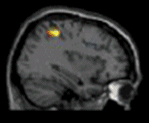
Figuur 1: Activatie van alleen de linker superieur pariëtale hersenschors vóór behandeling met neurofeedback
Na neurotherapie wordt duidelijk dat ook de cruciale anterieur cingulate gyrus kan worden geactiveerd (zie Figuur 2), hetgeen ook samengaat met betere prestaties op aandachtstaken.
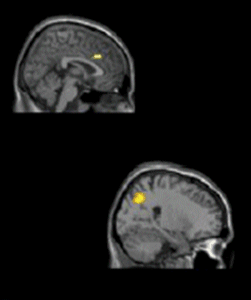
Figuur 2: Activatie van zowel de linker superieur pariëtale hersenschors als de rechter anterieur cingulate gyrus na behandeling met neurofeedback
Bij de ADHD-patiënten die ook opnieuw werden gescand maar geen neurofeedback behandeling hadden genoten, bleef deze frontale activatie achterwege (Figuur 3).
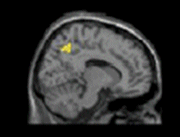
Figuur 3: Activatie van alleen de linker superieur pariëtale hersenschors zonder neurofeedback behandeling
De door ons gebruikte volgehouden aandachtstaak vertoont meestal ook duidelijke verschillen in aandachtsprestatie voor en tijdens/na behandeling.
Figuur 4 en 5 tonen van links naar rechts vier relevante parameters: volgehouden aandacht (aantal weglatingen), impulscontrole, reactiesnelheid en de stabiliteit van de reactietijd.
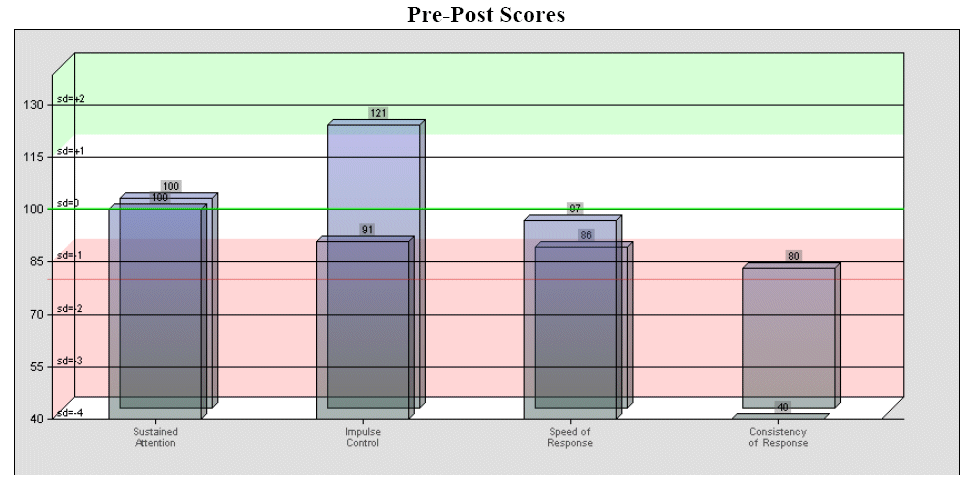
Figuur 4: Aandachtsprestatie vóór (voorste rij) en na 14 neurofeedback sessies (achterste rij)
Een score rond 100 (tussen 85 en 115) wordt beschouwd als een gemiddelde prestatie (genormeerd zoals een IQ-score).
Uit Fig. 4 blijkt dat deze patiënt een veel betere impulscontrole heeft gekregen (van score 91 naar een boven-gemiddelde score van 121, weliswaar gekoppeld aan een iets tragere reactietijd) en veel consistenter/stabieler kan werken (van de zeer lage score 40 naar een beneden-gemiddelde score van 80).
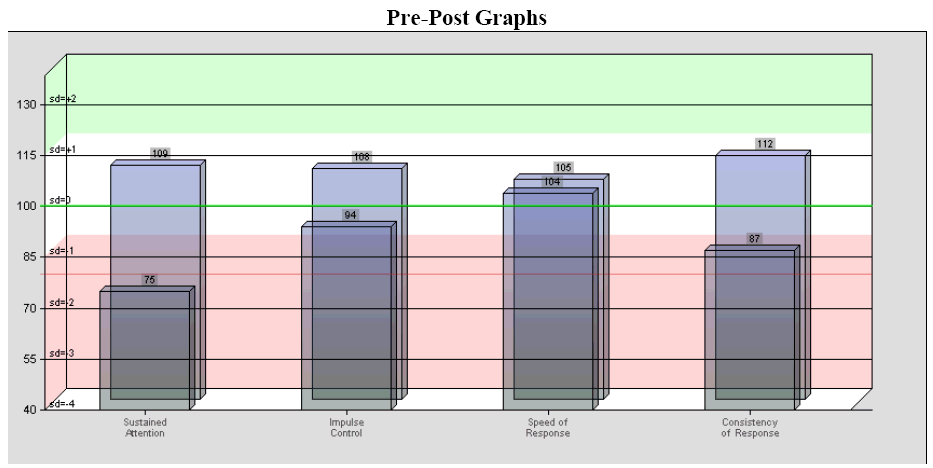
Figuur 5: Aandachtsprestatie vóór (voorste rij) en na 11 neurofeedback sessies (achterste rij)
Uit Fig. 5 blijkt dat deze patiënt zijn aandacht veel beter/langer kan vasthouden (van de probleemscore 75 naar een gemiddelde score van 109 (een grote vooruitgang van maar liefst 34 punten). Bovendien werkt de patiënt nu veel constanter dan voor de behandeling (een duidelijke vooruitgang van 87 naar 115). En bij een gelijkblijvende gemiddelde reactiesnelheid maakt hij ook minder impulsieve fouten (standaardscore stijgt van 94 naar 108).
ADHD-medicijnen bieden geen antwoord op lange termijn (bericht uit de krant De Morgen, 13 november 2007)
Gepubliceerde onderzoeksresultaten:
Lofthouse N, Arnold LE, Hersch S, Hurt E, DeBeus R. (2012). A review of neurofeedback treatment for pediatric ADHD. Journal of Attention Disorders, 16, 351-372.
Gevensleben, H., Rothenberger, A., Moll, G.H., Heinrich, H. (2012). Neurofeedback in children with ADHD: validation and challenges. Expert Rev Neurother, 12, 447-460.
Nan W, Rodrigues JP, Ma J, Qu X, Wan F, Mak PI, Mak PU, Vai MI, Rosa A. (2012). Individual alpha neurofeedback training effect on short term memory. Int J Psychophysiol, 86, 83-87.
Lofthouse N, Arnold LE, Hurt E. (2012). Current status of neurofeedback for attention-deficit/hyperactivity disorder. Curr Psychiatry Rep, 14, 536-42.
Arns M, Drinkenburg W, Leon Kenemans J. (2012). The Effects of QEEG-Informed Neurofeedback in ADHD: An Open-Label Pilot Study. Appl Psychophysiol Biofeedback, 37, 171-180.
Duric, N.S., Assmus, J., Gundersen, D.I., Elgen, I.B. (2012). Neurofeedback for the treatment of children and adolescents with ADHD: a randomized and controlled clinical trial using parental reports. BMC Psychiatry, 12, 107. doi:10.1186/1471-244X-12-107
Loo SK, Makeig S. (2012). Clinical Utility of EEG in Attention-Deficit/Hyperactivity Disorder: A Research Update. Neurotherapeutics, 9, 569-587.
Liechti MD, Maurizio S, Heinrich H, Jäncke L, Meier L, Steinhausen HC, Walitza S, Drechsler R, Brandeis D. (2012). First clinical trial of tomographic neurofeedback in attention-deficit/hyperactivity disorder: Evaluation of voluntary cortical control. Clin Neurophysiol, 123, 1989-2005.
Escolano C, Aguilar M, Minguez J. (2011). EEG-based upper alpha neurofeedback training improves working memory performance. Conf Proc IEEE Eng Med Biol Soc, 2327-2330.
Bakhshayesh AR, Hansch S, Wyschkon A, Rezai MJ, Esser G (2011). Neurofeedback in ADHD: a single-blind randomized controlled trial. Eur Child Adolesc Psychiatry, 20, 481-491.
Gevensleben H, Holl B, Albrecht B, Schlamp D, Kratz O, Studer P, Rothenberger A, Moll GH, Heinrich H. (2010). Neurofeedback training in children with ADHD: 6-month follow-up of a randomised controlled trial. Eur Child Adolesc Psychiatry, 19, 715-724.
Logemann HN, Lansbergen MM, Van Os TW, Bocker KB, Kenemans JL (2010). The effectiveness of EEG-feedback on attention, impulsivity and EEG: a sham feedback controlled study. Neurosci Lett, 479, 49–53.
Arns M, de Ridder S, Strehl U, Breteler M, Coenen A (2009). Efficacy of neurofeedback
treatment in ADHD: the effects on inattention, impulsivity and hyperactivity: a meta-analysis. Clin EEG Neurosci, 40, 180–189.
Gevensleben H, Holl B, Albrecht B, Vogel C, Schlamp D, Kratz O, Studer P,
Rothenberger A, Moll GH, Heinrich H (2009). Is neurofeedback an efficacious treatment for ADHD? A randomised controlled clinical trial. J Child Psychol Psychiatry, 50, 780–789.
Leins, U., Goth, G., Hinterberger, T., Klinger, C., Rumpf, N., Strehl, U. (2007). Neurofeedback for Children with ADHD: A Comparison of SCP and Theta/Beta Protocols. Appl Psychophysiol Biofeedback, 32, 73–88.
Beauregard,
M & Levesque, J (2006). Functional magnetic
resonance imaging investigation of the effects of neurofeedback
training on the neural bases of selective attention and response
inhibition in children with attention-deficit/hyperactivity disorder. Applied Psychophysiology &
Biofeedback, 31(1), 3-20.
Becerra, J., Fernandez, T., Harmony T., Caballero M.I, Garcia
F., Fernandez-Bouzas A., Santiago-Rodriguez E, Prado-Alcala R.A.
(2006) Follow-up study of Learning Disabled
children treated with Neurofeedback or placebo. Clinical EEG &
Neuroscience, 37(3), 198-203.
Boyd, W.D & Campbell, S.E. (1998) EEG biofeedback in
schools: The use of EEG biofeedback to treat ADHD in a school setting. Journal
of Neurotherapy, 2(4),
65-71.
Butnik, S.M. (2005). Neurofeedback in adolescents and adults with attention deficit hyperactivity disorder. J Clin Psychol, 61, 621-625.
Carmody, D. P., Radvanski, D. C., Wadhwani, S., Sabo, J. J.,
& Vergara, L. (2001). EEG biofeedback training and
attention-deficit/hyperactivity disorder in an elementary school
setting. Journal of Neurotherapy,
4(3), 5-27.
Fernandez, T., Harmony, T., Fernandez-Bouzas, A., Diaz-Comas,
L., Prado-Alcalá, R.A., Valdes-Sosa, P., Otero, G., Bosch,
J., Galan, L., Santiago-Rodriguez, E., Aubert, E.,
Garcia-Martinez, F. (2007). Changes
in
EEG current sources induced by neurofeedback in learning disabled
children. An exploratory study. Applied Psychophysiology &
Biofeedback, 32, 169-183.
Fernandez, T., Herrera, W., Harmony, T., Diaz-Comas, L.,
Santiago, E., Sanchez, L., Bosch, J., Fernandez-Bouzas, A., Otero, G.,
Ricardo-Garcell, J., Barraza, C., Aubert, E., Galan, L., &
Valdes, P. (2003). EEG and behavioral changes following neurofeedback
treatment in learning disabled children. Clinical Electroencephalography,
34(3), 145-152.
Fox, D. J., Tharp, D. F., & Fox, L. C. (2005).
Neurofeedback: An alternative and efficacious treatment for attention
deficit hyperactivity disorder. Applied Psychophysiology &
Biofeedback, 30(4), 365-274.
Fuchs, T., Birbaumer, N., Lutzenberger, W., Gruzelier, J. H.,
& Kaiser, J. (2003). Neurofeedback treatment for attention
deficit/hyperactivity disorder in children: A comparison with
methylphenidate. Applied Psychophysiology and
Biofeedback, 28, 1-12.
Hirshberg, L. M. (2007). Place of electroencephalographic
biofeedback for attention-deficit/hyperactivity disorder. Expert Review of Neurotherapeutics,
7(4), 315-319.
Kaiser, D. A., & Othmer, S. (2000). Effect of
Neurofeedback on variables of attention in a large multi-center trial. Journal
of Neurotherapy, 4(1), 5-15.
Kropotov, J. D., Grin-Yatsenko, V. A., Ponomarev, V. A.,
Chutko, L. S., Yakovenko, E. A., Nildshena, I. S. (2005). ERPs
correlates of EEG relative beta training in ADHD children. International Journal of
Psychophysiology, 55(1), 23-34.
Leins, U., Goth, G., Hinterberger, T., Klinger, C., Rumpf, M.,
& Strehl, U. (2007). Neurofeedback for Children with ADHD: A
Comparison of SCP and Theta/Beta Protocols. Applied Psychophysiology &
Biofeedback, 32, 73-88.
Lévesque, J., Beauregard, M., & Mensour, B. (2006).
Effect of neurofeedback training on the neural substrates of selective
attention in children with attention-deficit/hyperactivity disorder: a
functional magnetic resonance imaging study. Neuroscience Letters,
394(3), 216-221.
Linden, M., Habib, T., & Radojevic, V. (1996). A
controlled study of the effects of EEG biofeedback on cognition and
behavior of children with attention deficit disorder and learning
disabilities. Biofeedback
& Self-Regulation, 21(1), 35-49.
Lubar, J. F. (2003). Neurofeedback for the management of
attention deficit / hyperactivity disorders. Chapter in M. S. Schwartz
& F. Andrasik (Eds.), Biofeedback: A
Practitioner's Guide, Third Edition. New York, Guilford,
409-437.
Lubar, J. F., Swartwood, M. O., Swartwood, J. N., &
O'Donnell, P. H. (1995). Evaluation of the effectiveness of EEG
neurofeedback training for ADHD in a clinical setting as measured by
changes in T.O.V.A., scores, behavioral ratings, and WISC-R
performance. Biofeedback & Self-Regulation,
20(1), 83-99.
McKnight, J. T., & Fehmi,
L. G. (2001). Attention and neurofeedback synchrony training: Clinical
results and their significance. Journal
of Neurotherapy, 5(1-2), 45-62.
Monastra, V. J. (2005). Electroencephalographic biofeedback
(neurotherapy) as a treatment for attention deficit hyperactivity
disorder: Rationale and empirical foundation. Child & Adolescent
Psychiatric Clinics of North America, 14(1), 55-82.
Monastra, V. J., Lynn, S., Linden, M., Lubar, J. F., Gruzelier, J.,
& LaVaque, T. J. (2005). Electroencephalographic biofeedback in
the treatment of attention-deficit/hyperactivity disorder. Applied Psychophysiology &
Biofeedback, 30(2), 95-114.
Monastra, V. J., Monastra, D. M., & George, S. (2002).
The effects of stimulant therapy, EEG biofeedback, and parenting style
on the primary symptoms of attention-deficit/hyperactivity disorder. Applied Psychophysiology &
Biofeedback, 27(4), 231-249.
Nash, J. K. (2000). Treatment of
attention-deficit hyperactivity disorder with neurotherapy. Clinical Electroencephalography,
31(1), 30-37.
Orlando, P. C., & Rivera, R. O. (2004). Neurofeedback
for elementary students with identified learning problems. Journal of Neurotherapy,
8(2), 5-19.
Othmer, S.,
Othmer, S. F., & Kaiser, D. A. (1999). EEG
biofeedback: Training for AD/HD and related disruptive behavior
disorders. Chapter in J. A. Incorvaia & B. F. Mark-Goldstein,
& D. Tessmer (Eds.), Understanding,
Diagnosing, & Treating AD/HD in Children and Adolescents.
New York: Aronson, 235-297
Patrick, G.
J. (1996). Improved neuronal regulation in ADHD: An
application of 15 sessions of photic-driven EEG neurotherapy. Journal
of Neurotherapy, 1(4), 27-36.
Putnam, J. A., Othmer, S. F., Othmer, S., & Pollock,
V. E. (2005). TOVA results following interhemispheric bipolar EEG
training. Journal of Neurotherapy, 9(1), 37-52.
Rockstroh, B., Elbert, T., Lutzenberger, W., &
Birbaumer, N. (1990). Biofeedback: Evaluation and therapy in children
with attentional dysfunction. Chapter in A. Rothenberger (Ed.), Brain
and Behaviour in Child Psychiatry. Berlin: Springer Verlag,
pp. 345-357.
Rossiter, T. R. (2004). The
effectiveness of neurofeedback and stimulant drugs in treating AD/HD:
Part I. Review of methodological issues. Applied Psychophysiology &
Biofeedback, 29(2), 135-140.
Rossiter, T. R. (2005). The effectiveness of neurofeedback and
stimulant drugs in treating AD/HD: Part II.Replication. Applied Psychophysiology &
Biofeedback, 29(4), 233-243.
Rossiter, T. R., & La Vaque, T. J.
(1995). A comparison of EEG biofeedback and psychostimulants in
treating attention deficit/hyperactivity disorders. Journal
of Neurotherapy, 1, 48-59.
Shin, D. I., Lee, J. H., Lee, S. M., Kim, I. Y., &
Kim, S. I. (2004). Neurofeedback training with virtual reality for
inattention and impulsiveness. Cyberpsychology
& Behavior, 7(5), 519-526.
Strehl, U., Leins, U., Goth, G., Klinger, C., Hinterberger,
T., and Birbaumer, N. (2006).
Self-regulation of slow cortical potentials: A new treatment for
children with attention-deficit/hyperactivity disorder. Pediatrics, 118,
1530-1540.
Swingle, P. G. (2001).
Parameters associated with rapid neurotherapeutic treatment of common
ADD (CADD). Journal
of Neurotherapy, 5(4), 73-84.
Tansey, M. A. (1993). Ten-year
stability of EEG biofeedback results for a hyperactive boy who failed
fourth grade perceptually impaired class. Biofeedback & Self-Regulation, 18, 33-44.
Thompson, L., & Thompson, M. (1998). Neurofeedback
combined with training in metacognitive strategies: Effectiveness in
students with ADD. Applied Psychophysiology &
Biofeedback, 23(4), 243-263.
|

|
|
